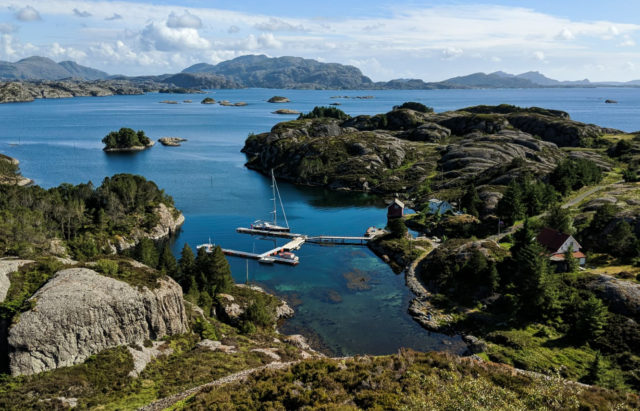Join our monthly email mailing list to get all the latest information and news from X-Yachts directly in your inbox.
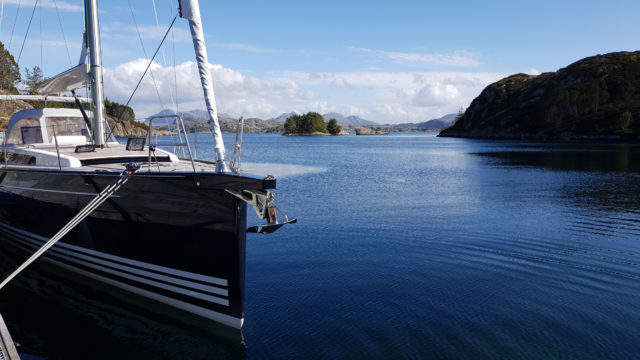
Epic Adventure
Fast Boat to Home By Susan and David Carrat

Fast Boat to Home By Susan and David Carrat
For download of full story in pdf: X-YACHTING_2019_56-59
May 2018 was the sunniest month for recorded weather in Denmark. Blue Vortex, a new X4⁹, was launched into this heat wave in the middle of May. Ahead of us lay 2,600 nautical miles of adventures in other kinds of waves; cold waves, wet waves & one huge, unexpected wave.
The spark for the adventure began when X-Yachts announced the X4⁹ in the middle of 2017. We placed an order for hull #4. In 2007, we had sailed our previous X-46 from Haderslev to Southampton as our first delivery trip which became known amongst our friends as the Epic Adventure, but that is another story! Since the original Epic Adventure we had gained a lot of sailing experience with long summer trips to Southern Ireland, the Atlantic Coast of France and Galicia from our base in the Hamble river near Southampton.
Eventually, we gave up any permanent mooring and sailed wherever we fancied on the beautiful coasts of Europe ending up in Barcelona. The script for Epic Adventure II, starring the X4⁹, was to sail the long way home from Haderslev to Southampton; north from Denmark, across the Skagerrak to Norway, as far north in Norway as we
would have time for, across the North Sea to the Shetland Islands, around the West coast of Scotland to Belfast in Northern Irleand. Eventually we would arrive in Southampton via Dublin and the Scilly Isles. The cast for the various scenes would include my wife Sue, my youngest son Steve and his friends, my long distance sailing buddy, Herman, and four other friends John, Jane, Bob & Yvonne.
The adventure started with an idyllic cruise around the island of Fyn near the yard lasting for two weeks. My wife Sue and our friends John & Jane, who are experienced sailors themselves, joined me. The idea was to test all the systems and learn the ropes. We were met by some Danish friends in Faaborg and we christened the boat by pouring a bottle of champagne over the bowsprit. I’m sure X-Yachts construction is great but I didn’t want to test it by smashing a bottle on the hull. Enough champagne remained for us to drink a little ourselves and this happy scene attracted a few admirers. A British flagged boat in Denmark attracts a lot of questions. At the end of two weeks in the sun and light winds we had tested what we could and returned to the yard for X-Yachts to
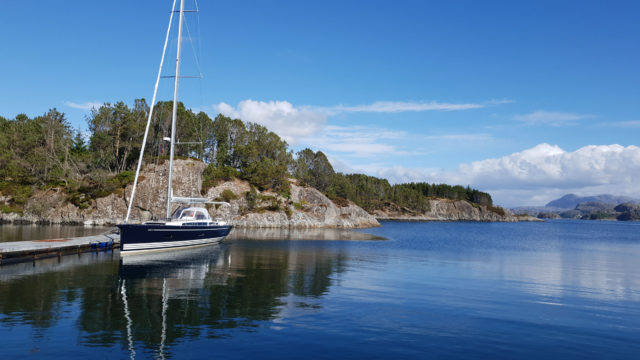

make minor modifications. A week later Herman and I set off double handed to sail the boat from Haderslev to Bergen, our first serious long distance trip. Immediately we set off, the heat wave ended. The warm weather turned and became cold and rainy. We arrived in Skagen at the northern tip of Denmark as it was getting dark and tied up in the shadow of the enormous trawlers being fitted out at Karstensens Shipyard.
Karstensens has constructed some of the largest fishing vessels on the planet destined for the Danish, Iceland, Ireland or Norway fishing fleets. These trawlers can be over 60m LOA and more than 1200 GRT. Skagen is a crossroads for cruisers from Denmark, the south coast of Norway and west coast of Sweden. There is great camaraderie and a serious drinking culture; I declined aquavit shots for breakfast! We motored across the Skagerrak in a flat calm which ticked off one of the potentially more difficult crossings on the route.
We sailed north through the islands between Stavanger and Bergen revelling in the stronger winds and protected water. Around this time I was a bit concerned about getting the first 50 hour engine service done. A quick check on the Yanmar dealer network and a few phone calls had us booked into a dealer on the island of Bømlo. We arrived to an impossible mooring puzzle - we had to slot ourselves alongside an Xc 45 (we felt in good company!) between a very wide fishing vessel and a rusty, dangerous looking, buoy that looked intent on ruining our pristine topsides. I motored around for a while thinking about other equally unattractive options - anchoring or tying up to a wall. A sternthruster would have been an attractive option at this point. I plucked up the courage to slam the boat into the available space and managed to stop the boat before hitting the ugly buoy but relied heavily on the fenders to stop alongside the Xc 45. We had arrived! About midnight, the wide fishing vessel behind us called us to ask “Do you like salmon?” and then cast off. We thought this was a strange question but in the morning the fishing boat had returned and left us a whole
fresh salmon from the fish farm in the cockpit. While the engine was being serviced the next morning I cut up the enormous fish and put it in the freezer. I have never seen such a fresh salmon.We sailed on north towards Bergen. One reach with 15 knots of true wind had the boat sailing at 9 knots through the water with only 15 degrees of heel. The wheel was very responsive with only the lightest touch being necessary to keep up the pace. The boat felt very fast and stable. I wanted to sail forever on that leg but we had to bear off to follow our route up the Bømlofjord via the Nyleia. The Nyleia is a perfect picture postcard piece of Norwegian landscape with small farms and second homes dotted amongst rocky hills and very characteristic low lighthouses This was an area we could have cruised for a couple of days but we had a schedule to keep and we sailed on to arrive at Hjellestad near Bergen airport. I left the boat in Hjellestad for a week while I went home for some R&R.
We sailed by way of the Vaerlandet islands towards Florø. Although we had experienced some remote islands we had never felt completely isolated. Florø is a small town with a population of about 9000 and doesn’t feel very remote. We wanted to experience uninhabited islands with few visitors, so we returned to the Solund area of western Norway. Solund is comprised of hundreds of islands with a land area of about 230 km2. The population is less than 800 making it unlikely you will meet anyone. We tied up at a remote jetty on Færøyna with views of all the islands around us for miles.
I left the boat in Hjellestad again and returned a week later, in early July, with two friends, Bob & Yvonne, with the aim of sailing from Norway to Ireland by way of the Shetland Islands and the west coast of Scotland. The three of us had not sailed together before and so we spent the first week exploring the protected Hardangerfjord south of Bergen to get to know each other and the boat. It was picturesque with the Folgefonna glacier visible in the upper reaches of the fjord.
Leaving late afternoon we crossed the North Sea from Bekkjarvik to Lerwick in the Shetland Isles in 28 hours. We left Kirkwall in Orkney in the morning motoring in light wind and mist. I had a sense of foreboding. The crossing from Orkney to Cape Wrath is very committing
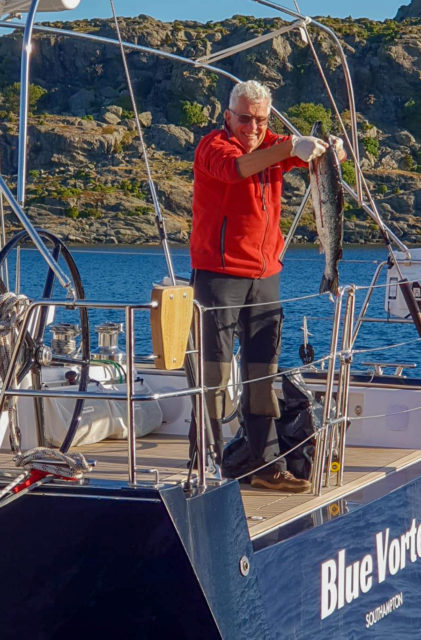
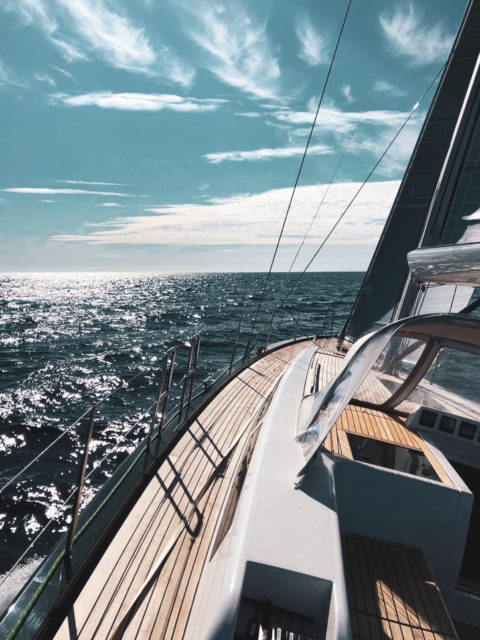
There are no diversionary ports and the only choice is to go on to Kinlochbervie on the mainland of Scotland (past Cape Wrath) or turn around and head back to Orkney. I like to have options and there were none. I was nervous. I had decided to leave Orkney by Eynhallow Sound - one of the seaways which divides the mainland from the northern islands of Rousay, Shapinsay, Westray etc.
Eynhallow is an abandoned island which according to Orkney folklore was the magical, summer home of the Finfolk - a race of shapeshifting underwater dwelling creatures who abduct humans to become their wives and husbands.
I had plotted the course to the south of Eynhallow in a wide channel with 5 metres depth. As we approached the passage into the open sea I could see a line of breakers right across the channel. They looked 2 metres high. Breaking waves 2 metres high in a tidal race would require some consideration and in a different situation I would have motored ahead to cross them. However, in a 5 metre deep channel I was very concerned about what the actual depth under the 2.4m keel could be as we would be tossed around in troughs of the waves. I decided to turn around and take the deeper channel route to the north of Eynhallow.
The northern route is deep and narrow and I was confident that we could pilot our way through the channel keeping in more than 20 metres depth of water. We entered the channel and immediately the boat was sucked into a 4 knot current. SOG increased to 12 knots and for a while I was thinking “this is exhilarating - we will pass Eynhallow in no time at all!” Shortly after this thought I saw a huge wall of water ahead of us. It was a standing wave, 5 metres high, created by the firehose of water coming out of the Sound and spewing into the open sea at 4 knots. There was hardly any time to think and certainly not enough time to go and read the pilot books again. I decided to let the boat run on and turned to hit the wave head on. The wave hit slightly to starboard and fell on top of the boat like the tonnes of green water that it was. The wave
visitors exploded on the deck just behind the mast and on top of the sprayhood. I was terrified about what would come next. Time seemed to slow to a crawl as a thousand possibilities crossed my mind. Would the boat be rolled by the breaking wave and throw somebody out of the boat. How long would this last? We couldn’t put up with this punishment for more than a few waves - certainly not for the mile required to get into open water. As it turned out, the first wave was the largest and after two or three large breakers we were in more typical rough water. I was in shock with the metallic taste of adrenaline in my mouth. I was already reproaching myself for a stupid skipper decision but this was no time for analysis. We took stock of the situation.
Bob & Yvonne were wet but not hurt. Bob had held onto the frame of the sprayhood to stabilise himself. Yvonne had held onto the cockpit table. The only damage was a screw ripped out of one of the sprayhood fixings. The trip with Bob & Yvonne continued through the Scottish Outer Hebrides stopping at Kinlochbervie, Tobermory and Port Ellen before our final destination of Bangor, near Belfast in Northern Ireland. We arrived in Bangor marina at midnight and celebrated with a few beers and impromptu snacks.
We had survived the Eynhallow Roost, the largest standing wave I have ever seen!
